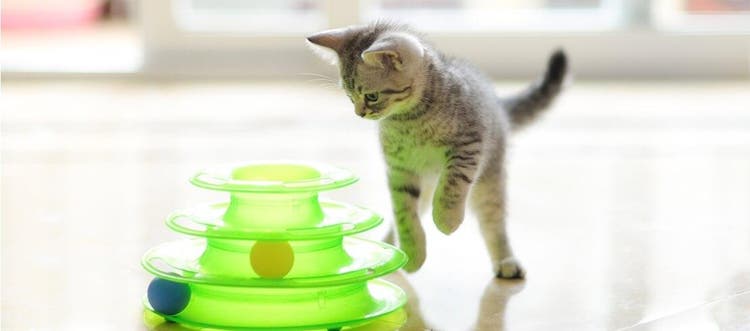Having a pet can be a wonderful way to teach your child about caring and responsibility. These tips will ensure your cat and child form a safe and strong bond.
The bond between a child and their pet cat can enrich your child’s life and teach them important lessons about empathy and responsibility. When introducing a cat or kitten to a child, however, it’s important to ensure everyone’s safety and take steps to strengthen their bond from the start. The following tips will help your child enjoy a safe and positive relationship with their new cat.
Safe play
Tips for bonding
Interactions between your child and your pet should always be supervised by an adult. Appropriate interactions will depend on the age of your child.
Teaching your kids how to play with their cat and care for them properly is a great way of helping them to bond. Never let your child use their hands or feet to play with their cat. Instead, encourage them to use toys on long sticks or “fishing rods”. Your child can also feed the cat, as this is a highly positive bonding experience and it teaches your child responsibility. In addition, unless your child has cat allergies or the cat is unfriendly, there is nothing wrong with allowing the cat to sleep on your child’s bed to cement the relationship.
Note: It is never recommended for a cat to sleep in a crib with a baby.
Common problems
Your child should learn what affection your cat enjoys, such as cheek rubs, chin scratches or being stroked along the cat’s back. It’s also important that your child gets to know when the cat has had enough, by learning to read their body language. If your cat displays aggression that appears to be unprovoked, you should have your cat assessed by your veterinarian.
Teach your child not to be too boisterous around the cat. Cats are both predator and prey animals, so they’re always on alert for danger. If your cat hides and takes a long time to come out, they may be suffering from anxiety. In this case, it would be best for your child to back off and give your cat more space to come out and socialize on their own terms. If the fearfulness persists, however, a behavioural assessment of your cat and your environment may be helpful.
Training your cat
Tips for bonding
If your children are old enough, they may have fun learning how to train your cat through clicker training. It is a myth that cats can’t be trained. In fact, cats learn in the same ways as other animals do and can be motivated to follow cues for small amounts of food. Using a clicker makes the communication clear and consistent, which is why it’s a safe and productive way for your child to create a special bond with your cat.
Common problems
Cats can sometimes be out of sync with their human families. Some children may have a tendency to treat them like fluffy toys and fail to recognize that cats need their own personal space and have likes and dislikes. If the cat’s needs are not being met and they feel cornered, they could resort to aggression.
Owners can help ensure cats are treated properly and respectfully by following the Five Pillars of Feline Enrichment guidelines. These outline cats‘ five essential needs which are:
- Access to resources such as food, water, a litter box, scratching areas and resting areas
- A place to evade and avoid that will provide them with a sense of security, this can be an elevated area such as a perch
- Times to practice play and predation
- Positive communication with people
- Respecting the importance of cats’ heightened sense of smell by avoiding the use of strong smelling cleaners and providing your cat with a scratching area to mark with his scent
Fulfilling these five essential needs in your cat will make it easier for them to adapt and thrive in your family.
Be gentle
Tips for bonding
It’s important to use positive language with your child to help create a bond between them and the cat. For example, a reminder such as “Gentle hands!” is far more productive than a negative command like, “Don’t touch the cat!”
Young children and toddlers can be taught to stand or sit to one side of the cat, rather than approaching them from the top or the front, which can be perceived by the cat as more threatening. Children should be encouraged to stroke the cat softly and calmly using open hands. If you have older children, you can teach them to watch out for certain poses and expressions that mean the cat is afraid or upset.
Always lead by example. Handle your cat gently and give the cat space when they’ve had enough. This way, your child will learn to emulate your behaviour.
Another thing to remember is that children will generally feel more bonded if they are involved in taking care of the cat. Let your child (if age appropriate) help feed and groom the cat or involve the younger children in helping you care for the cat. Most cats thrive on routine. If the routine involves the children your cat will grow to trust them more and associate them with positive things, like food and brushing. Born hunters, cats require a lot of mental stimulation, so encourage your children to play with the cat using the cat’s favourite toys. Your cat and your children will both get great exercise and burn off energy playing together!
Common problems
Cats can become agitated or aggressive if they’re handled in a way they don’t like. If you are unsure how to handle your cat properly, consult your veterinarian or a local behavioural specialist.
Create empathy
Tips for bonding
Owning a cat has many benefits for your child, as it will teach them about empathy, compassion, friendship, maturity and the responsibility of caring for another. Involving your child in the care of the cat helps create a strong bond between them.
Talk to your child about the cat’s feelings while the two of them are interacting. This will help your child understand the impact that they have on the cat’s wellbeing. Let your child know when they are doing something positive that the cat obviously enjoys, such as, “Kitty loves it when you brush her hair like that”.
The benefits for children
Cats can be highly beneficial for children’s mental health. Research shows that having pets can promote self-esteem in children, increase their social skills and improve their ability to make connections. In some instances, pets have been shown to assist children with developmental conditions such as Autistic Spectrum Disorder (ASD). Pets can help these children interact with family members better and participate more in the life of the household.
It is important to take your family’s individual circumstances into account before committing to a cat, but pets generally provide significant benefits for both the children and adults in the household. They are a source of unconditional love for everyone in the family and are always a “friend” for children to come home to.
Growing up with a pet is lots of fun for children, and it also teaches them important lessons like being caring, patient and understanding. Follow these tips to help teach your child the correct ways to interact with and care for your cat, so they will forge a lasting bond and friendship they will both cherish.









